Whirlpool & Inland Steel: Strategic Procurement and Supply Chains
VerifiedAdded on 2023/06/11
|8
|1988
|54
Case Study
AI Summary
This case study examines the strategic alliance between Whirlpool Corporation and Inland Steel, focusing on cost reduction and supply chain precision. It discusses the importance of buyer-seller partnerships, strategic fit, and the impact of point-to-point communication between functional groups. The analysis covers how companies can measure the success of such partnerships through internal and external parameters like profit, market position, and employee turnover. It also explores the advantages and disadvantages of single-sourcing strategies in leveraging product portfolios, highlighting the risks associated with over-dependence on a single supplier versus the benefits in industries like construction and automobile manufacturing where continuous operation support and high-quality parts are critical. The case study references academic sources to support its analysis of strategic procurement management.

Running head: COST CUTTING AND SUPPLY CHAIN PRECISION
Cost Cutting and Supply Chain Precision
Name of the Student:
Name of the University:
Author Note:
Cost Cutting and Supply Chain Precision
Name of the Student:
Name of the University:
Author Note:
Paraphrase This Document
Need a fresh take? Get an instant paraphrase of this document with our AI Paraphraser
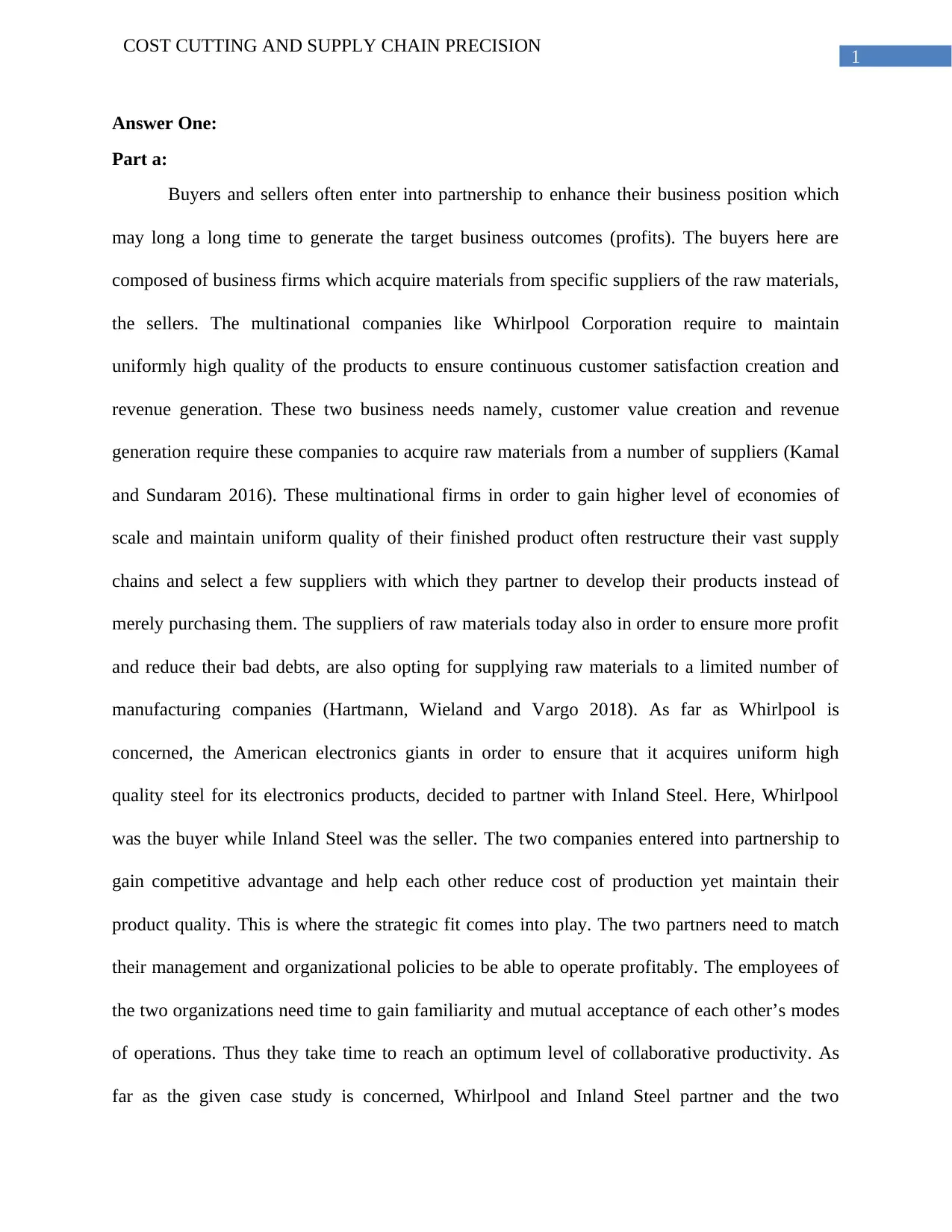
1
COST CUTTING AND SUPPLY CHAIN PRECISION
Answer One:
Part a:
Buyers and sellers often enter into partnership to enhance their business position which
may long a long time to generate the target business outcomes (profits). The buyers here are
composed of business firms which acquire materials from specific suppliers of the raw materials,
the sellers. The multinational companies like Whirlpool Corporation require to maintain
uniformly high quality of the products to ensure continuous customer satisfaction creation and
revenue generation. These two business needs namely, customer value creation and revenue
generation require these companies to acquire raw materials from a number of suppliers (Kamal
and Sundaram 2016). These multinational firms in order to gain higher level of economies of
scale and maintain uniform quality of their finished product often restructure their vast supply
chains and select a few suppliers with which they partner to develop their products instead of
merely purchasing them. The suppliers of raw materials today also in order to ensure more profit
and reduce their bad debts, are also opting for supplying raw materials to a limited number of
manufacturing companies (Hartmann, Wieland and Vargo 2018). As far as Whirlpool is
concerned, the American electronics giants in order to ensure that it acquires uniform high
quality steel for its electronics products, decided to partner with Inland Steel. Here, Whirlpool
was the buyer while Inland Steel was the seller. The two companies entered into partnership to
gain competitive advantage and help each other reduce cost of production yet maintain their
product quality. This is where the strategic fit comes into play. The two partners need to match
their management and organizational policies to be able to operate profitably. The employees of
the two organizations need time to gain familiarity and mutual acceptance of each other’s modes
of operations. Thus they take time to reach an optimum level of collaborative productivity. As
far as the given case study is concerned, Whirlpool and Inland Steel partner and the two
COST CUTTING AND SUPPLY CHAIN PRECISION
Answer One:
Part a:
Buyers and sellers often enter into partnership to enhance their business position which
may long a long time to generate the target business outcomes (profits). The buyers here are
composed of business firms which acquire materials from specific suppliers of the raw materials,
the sellers. The multinational companies like Whirlpool Corporation require to maintain
uniformly high quality of the products to ensure continuous customer satisfaction creation and
revenue generation. These two business needs namely, customer value creation and revenue
generation require these companies to acquire raw materials from a number of suppliers (Kamal
and Sundaram 2016). These multinational firms in order to gain higher level of economies of
scale and maintain uniform quality of their finished product often restructure their vast supply
chains and select a few suppliers with which they partner to develop their products instead of
merely purchasing them. The suppliers of raw materials today also in order to ensure more profit
and reduce their bad debts, are also opting for supplying raw materials to a limited number of
manufacturing companies (Hartmann, Wieland and Vargo 2018). As far as Whirlpool is
concerned, the American electronics giants in order to ensure that it acquires uniform high
quality steel for its electronics products, decided to partner with Inland Steel. Here, Whirlpool
was the buyer while Inland Steel was the seller. The two companies entered into partnership to
gain competitive advantage and help each other reduce cost of production yet maintain their
product quality. This is where the strategic fit comes into play. The two partners need to match
their management and organizational policies to be able to operate profitably. The employees of
the two organizations need time to gain familiarity and mutual acceptance of each other’s modes
of operations. Thus they take time to reach an optimum level of collaborative productivity. As
far as the given case study is concerned, Whirlpool and Inland Steel partner and the two
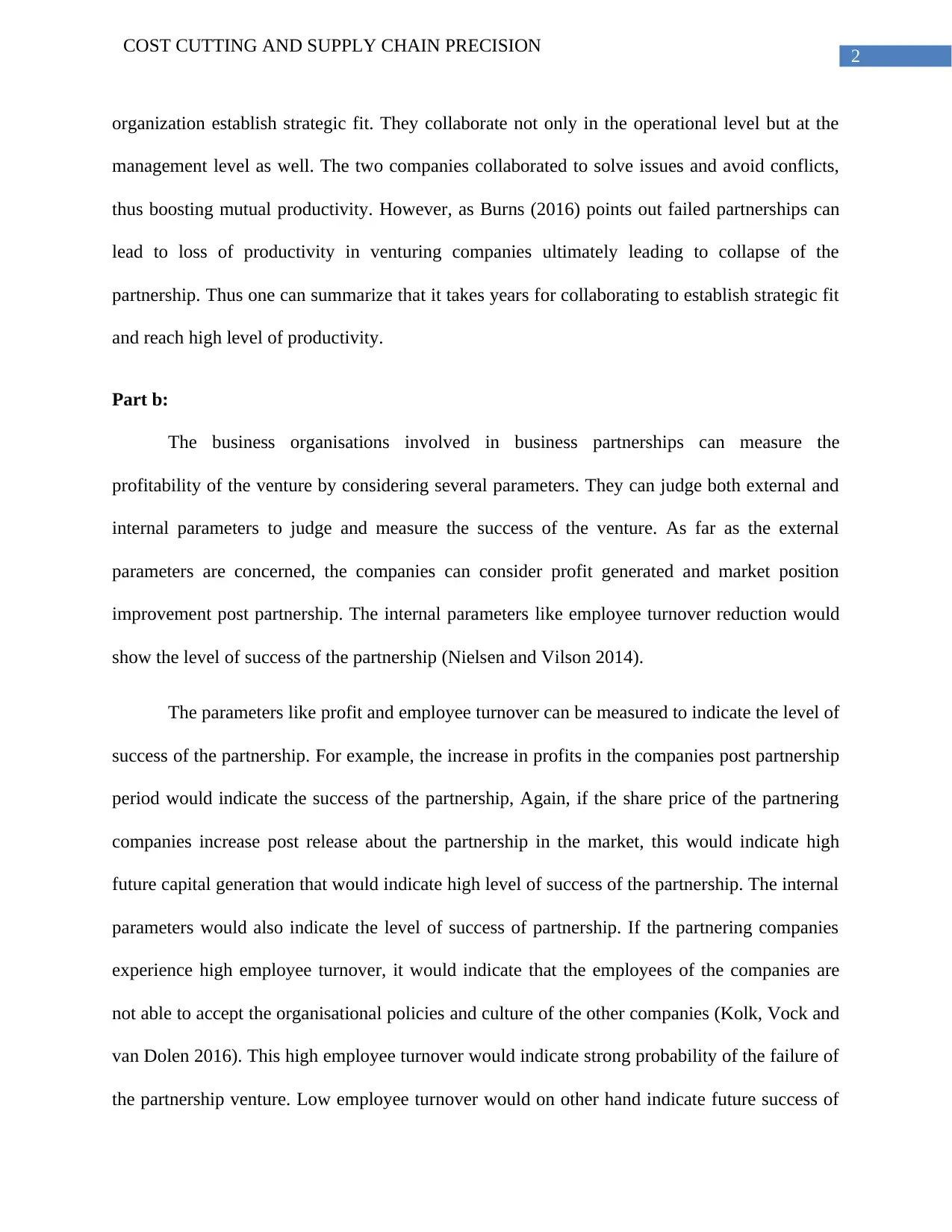
2
COST CUTTING AND SUPPLY CHAIN PRECISION
organization establish strategic fit. They collaborate not only in the operational level but at the
management level as well. The two companies collaborated to solve issues and avoid conflicts,
thus boosting mutual productivity. However, as Burns (2016) points out failed partnerships can
lead to loss of productivity in venturing companies ultimately leading to collapse of the
partnership. Thus one can summarize that it takes years for collaborating to establish strategic fit
and reach high level of productivity.
Part b:
The business organisations involved in business partnerships can measure the
profitability of the venture by considering several parameters. They can judge both external and
internal parameters to judge and measure the success of the venture. As far as the external
parameters are concerned, the companies can consider profit generated and market position
improvement post partnership. The internal parameters like employee turnover reduction would
show the level of success of the partnership (Nielsen and Vilson 2014).
The parameters like profit and employee turnover can be measured to indicate the level of
success of the partnership. For example, the increase in profits in the companies post partnership
period would indicate the success of the partnership, Again, if the share price of the partnering
companies increase post release about the partnership in the market, this would indicate high
future capital generation that would indicate high level of success of the partnership. The internal
parameters would also indicate the level of success of partnership. If the partnering companies
experience high employee turnover, it would indicate that the employees of the companies are
not able to accept the organisational policies and culture of the other companies (Kolk, Vock and
van Dolen 2016). This high employee turnover would indicate strong probability of the failure of
the partnership venture. Low employee turnover would on other hand indicate future success of
COST CUTTING AND SUPPLY CHAIN PRECISION
organization establish strategic fit. They collaborate not only in the operational level but at the
management level as well. The two companies collaborated to solve issues and avoid conflicts,
thus boosting mutual productivity. However, as Burns (2016) points out failed partnerships can
lead to loss of productivity in venturing companies ultimately leading to collapse of the
partnership. Thus one can summarize that it takes years for collaborating to establish strategic fit
and reach high level of productivity.
Part b:
The business organisations involved in business partnerships can measure the
profitability of the venture by considering several parameters. They can judge both external and
internal parameters to judge and measure the success of the venture. As far as the external
parameters are concerned, the companies can consider profit generated and market position
improvement post partnership. The internal parameters like employee turnover reduction would
show the level of success of the partnership (Nielsen and Vilson 2014).
The parameters like profit and employee turnover can be measured to indicate the level of
success of the partnership. For example, the increase in profits in the companies post partnership
period would indicate the success of the partnership, Again, if the share price of the partnering
companies increase post release about the partnership in the market, this would indicate high
future capital generation that would indicate high level of success of the partnership. The internal
parameters would also indicate the level of success of partnership. If the partnering companies
experience high employee turnover, it would indicate that the employees of the companies are
not able to accept the organisational policies and culture of the other companies (Kolk, Vock and
van Dolen 2016). This high employee turnover would indicate strong probability of the failure of
the partnership venture. Low employee turnover would on other hand indicate future success of
⊘ This is a preview!⊘
Do you want full access?
Subscribe today to unlock all pages.

Trusted by 1+ million students worldwide
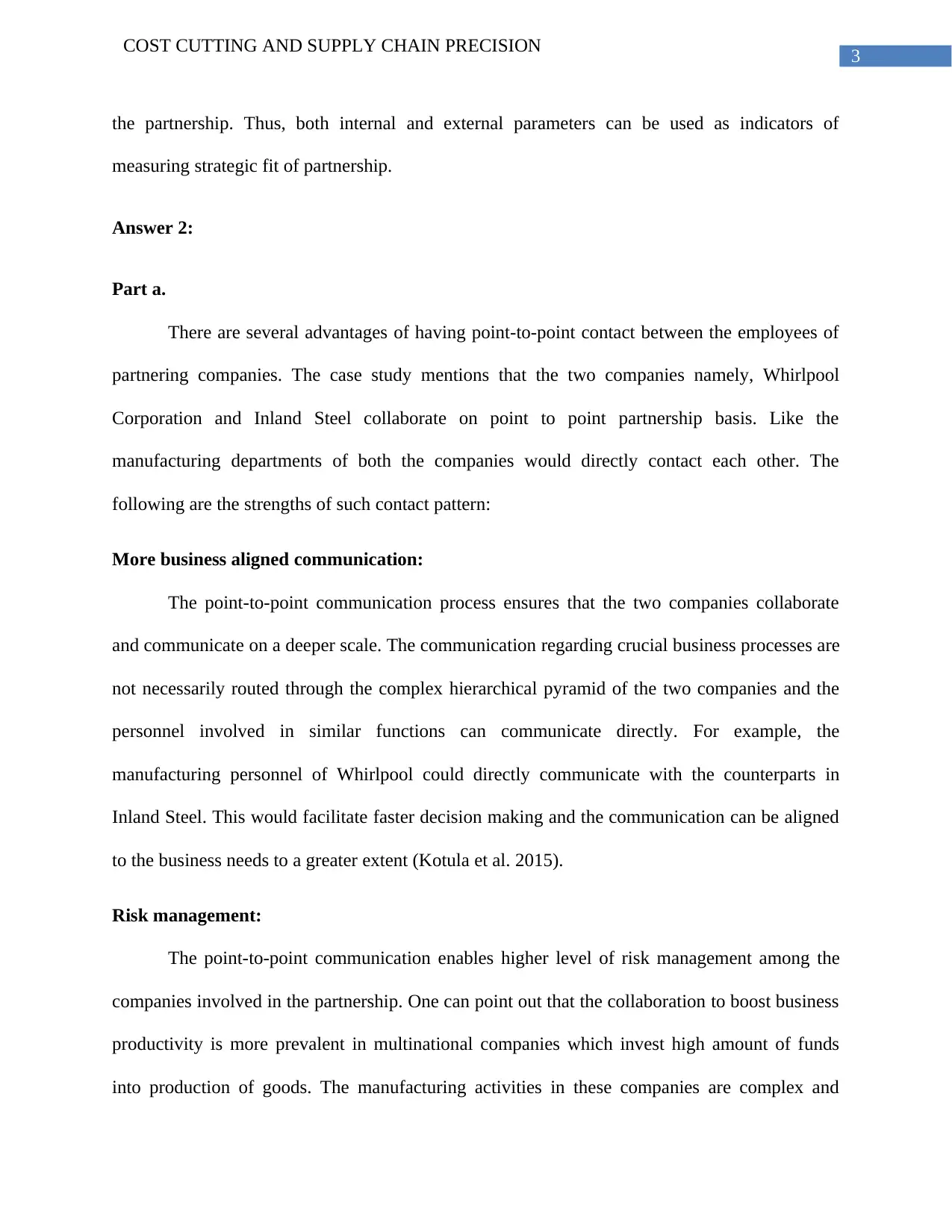
3
COST CUTTING AND SUPPLY CHAIN PRECISION
the partnership. Thus, both internal and external parameters can be used as indicators of
measuring strategic fit of partnership.
Answer 2:
Part a.
There are several advantages of having point-to-point contact between the employees of
partnering companies. The case study mentions that the two companies namely, Whirlpool
Corporation and Inland Steel collaborate on point to point partnership basis. Like the
manufacturing departments of both the companies would directly contact each other. The
following are the strengths of such contact pattern:
More business aligned communication:
The point-to-point communication process ensures that the two companies collaborate
and communicate on a deeper scale. The communication regarding crucial business processes are
not necessarily routed through the complex hierarchical pyramid of the two companies and the
personnel involved in similar functions can communicate directly. For example, the
manufacturing personnel of Whirlpool could directly communicate with the counterparts in
Inland Steel. This would facilitate faster decision making and the communication can be aligned
to the business needs to a greater extent (Kotula et al. 2015).
Risk management:
The point-to-point communication enables higher level of risk management among the
companies involved in the partnership. One can point out that the collaboration to boost business
productivity is more prevalent in multinational companies which invest high amount of funds
into production of goods. The manufacturing activities in these companies are complex and
COST CUTTING AND SUPPLY CHAIN PRECISION
the partnership. Thus, both internal and external parameters can be used as indicators of
measuring strategic fit of partnership.
Answer 2:
Part a.
There are several advantages of having point-to-point contact between the employees of
partnering companies. The case study mentions that the two companies namely, Whirlpool
Corporation and Inland Steel collaborate on point to point partnership basis. Like the
manufacturing departments of both the companies would directly contact each other. The
following are the strengths of such contact pattern:
More business aligned communication:
The point-to-point communication process ensures that the two companies collaborate
and communicate on a deeper scale. The communication regarding crucial business processes are
not necessarily routed through the complex hierarchical pyramid of the two companies and the
personnel involved in similar functions can communicate directly. For example, the
manufacturing personnel of Whirlpool could directly communicate with the counterparts in
Inland Steel. This would facilitate faster decision making and the communication can be aligned
to the business needs to a greater extent (Kotula et al. 2015).
Risk management:
The point-to-point communication enables higher level of risk management among the
companies involved in the partnership. One can point out that the collaboration to boost business
productivity is more prevalent in multinational companies which invest high amount of funds
into production of goods. The manufacturing activities in these companies are complex and
Paraphrase This Document
Need a fresh take? Get an instant paraphrase of this document with our AI Paraphraser
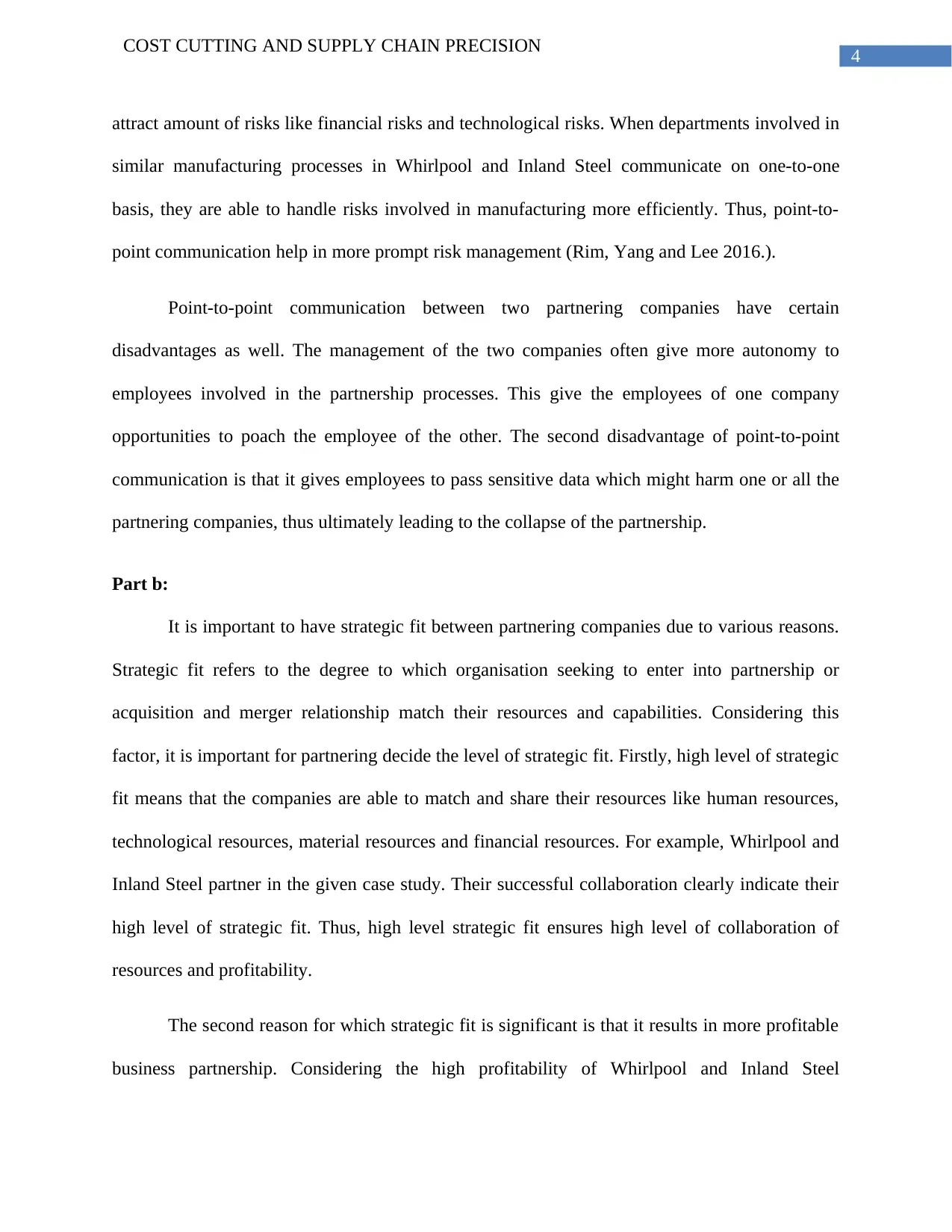
4
COST CUTTING AND SUPPLY CHAIN PRECISION
attract amount of risks like financial risks and technological risks. When departments involved in
similar manufacturing processes in Whirlpool and Inland Steel communicate on one-to-one
basis, they are able to handle risks involved in manufacturing more efficiently. Thus, point-to-
point communication help in more prompt risk management (Rim, Yang and Lee 2016.).
Point-to-point communication between two partnering companies have certain
disadvantages as well. The management of the two companies often give more autonomy to
employees involved in the partnership processes. This give the employees of one company
opportunities to poach the employee of the other. The second disadvantage of point-to-point
communication is that it gives employees to pass sensitive data which might harm one or all the
partnering companies, thus ultimately leading to the collapse of the partnership.
Part b:
It is important to have strategic fit between partnering companies due to various reasons.
Strategic fit refers to the degree to which organisation seeking to enter into partnership or
acquisition and merger relationship match their resources and capabilities. Considering this
factor, it is important for partnering decide the level of strategic fit. Firstly, high level of strategic
fit means that the companies are able to match and share their resources like human resources,
technological resources, material resources and financial resources. For example, Whirlpool and
Inland Steel partner in the given case study. Their successful collaboration clearly indicate their
high level of strategic fit. Thus, high level strategic fit ensures high level of collaboration of
resources and profitability.
The second reason for which strategic fit is significant is that it results in more profitable
business partnership. Considering the high profitability of Whirlpool and Inland Steel
COST CUTTING AND SUPPLY CHAIN PRECISION
attract amount of risks like financial risks and technological risks. When departments involved in
similar manufacturing processes in Whirlpool and Inland Steel communicate on one-to-one
basis, they are able to handle risks involved in manufacturing more efficiently. Thus, point-to-
point communication help in more prompt risk management (Rim, Yang and Lee 2016.).
Point-to-point communication between two partnering companies have certain
disadvantages as well. The management of the two companies often give more autonomy to
employees involved in the partnership processes. This give the employees of one company
opportunities to poach the employee of the other. The second disadvantage of point-to-point
communication is that it gives employees to pass sensitive data which might harm one or all the
partnering companies, thus ultimately leading to the collapse of the partnership.
Part b:
It is important to have strategic fit between partnering companies due to various reasons.
Strategic fit refers to the degree to which organisation seeking to enter into partnership or
acquisition and merger relationship match their resources and capabilities. Considering this
factor, it is important for partnering decide the level of strategic fit. Firstly, high level of strategic
fit means that the companies are able to match and share their resources like human resources,
technological resources, material resources and financial resources. For example, Whirlpool and
Inland Steel partner in the given case study. Their successful collaboration clearly indicate their
high level of strategic fit. Thus, high level strategic fit ensures high level of collaboration of
resources and profitability.
The second reason for which strategic fit is significant is that it results in more profitable
business partnership. Considering the high profitability of Whirlpool and Inland Steel
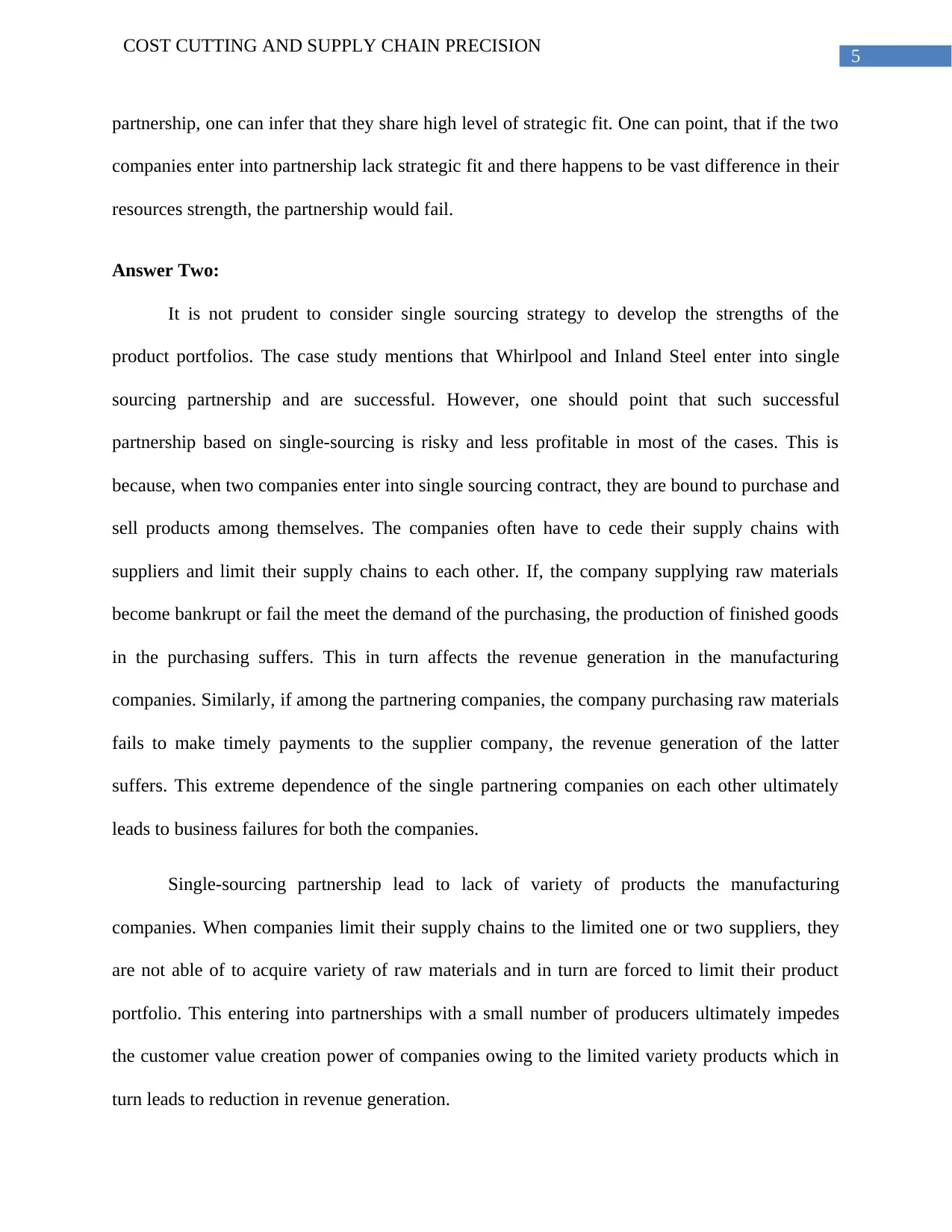
5
COST CUTTING AND SUPPLY CHAIN PRECISION
partnership, one can infer that they share high level of strategic fit. One can point, that if the two
companies enter into partnership lack strategic fit and there happens to be vast difference in their
resources strength, the partnership would fail.
Answer Two:
It is not prudent to consider single sourcing strategy to develop the strengths of the
product portfolios. The case study mentions that Whirlpool and Inland Steel enter into single
sourcing partnership and are successful. However, one should point that such successful
partnership based on single-sourcing is risky and less profitable in most of the cases. This is
because, when two companies enter into single sourcing contract, they are bound to purchase and
sell products among themselves. The companies often have to cede their supply chains with
suppliers and limit their supply chains to each other. If, the company supplying raw materials
become bankrupt or fail the meet the demand of the purchasing, the production of finished goods
in the purchasing suffers. This in turn affects the revenue generation in the manufacturing
companies. Similarly, if among the partnering companies, the company purchasing raw materials
fails to make timely payments to the supplier company, the revenue generation of the latter
suffers. This extreme dependence of the single partnering companies on each other ultimately
leads to business failures for both the companies.
Single-sourcing partnership lead to lack of variety of products the manufacturing
companies. When companies limit their supply chains to the limited one or two suppliers, they
are not able of to acquire variety of raw materials and in turn are forced to limit their product
portfolio. This entering into partnerships with a small number of producers ultimately impedes
the customer value creation power of companies owing to the limited variety products which in
turn leads to reduction in revenue generation.
COST CUTTING AND SUPPLY CHAIN PRECISION
partnership, one can infer that they share high level of strategic fit. One can point, that if the two
companies enter into partnership lack strategic fit and there happens to be vast difference in their
resources strength, the partnership would fail.
Answer Two:
It is not prudent to consider single sourcing strategy to develop the strengths of the
product portfolios. The case study mentions that Whirlpool and Inland Steel enter into single
sourcing partnership and are successful. However, one should point that such successful
partnership based on single-sourcing is risky and less profitable in most of the cases. This is
because, when two companies enter into single sourcing contract, they are bound to purchase and
sell products among themselves. The companies often have to cede their supply chains with
suppliers and limit their supply chains to each other. If, the company supplying raw materials
become bankrupt or fail the meet the demand of the purchasing, the production of finished goods
in the purchasing suffers. This in turn affects the revenue generation in the manufacturing
companies. Similarly, if among the partnering companies, the company purchasing raw materials
fails to make timely payments to the supplier company, the revenue generation of the latter
suffers. This extreme dependence of the single partnering companies on each other ultimately
leads to business failures for both the companies.
Single-sourcing partnership lead to lack of variety of products the manufacturing
companies. When companies limit their supply chains to the limited one or two suppliers, they
are not able of to acquire variety of raw materials and in turn are forced to limit their product
portfolio. This entering into partnerships with a small number of producers ultimately impedes
the customer value creation power of companies owing to the limited variety products which in
turn leads to reduction in revenue generation.
⊘ This is a preview!⊘
Do you want full access?
Subscribe today to unlock all pages.

Trusted by 1+ million students worldwide
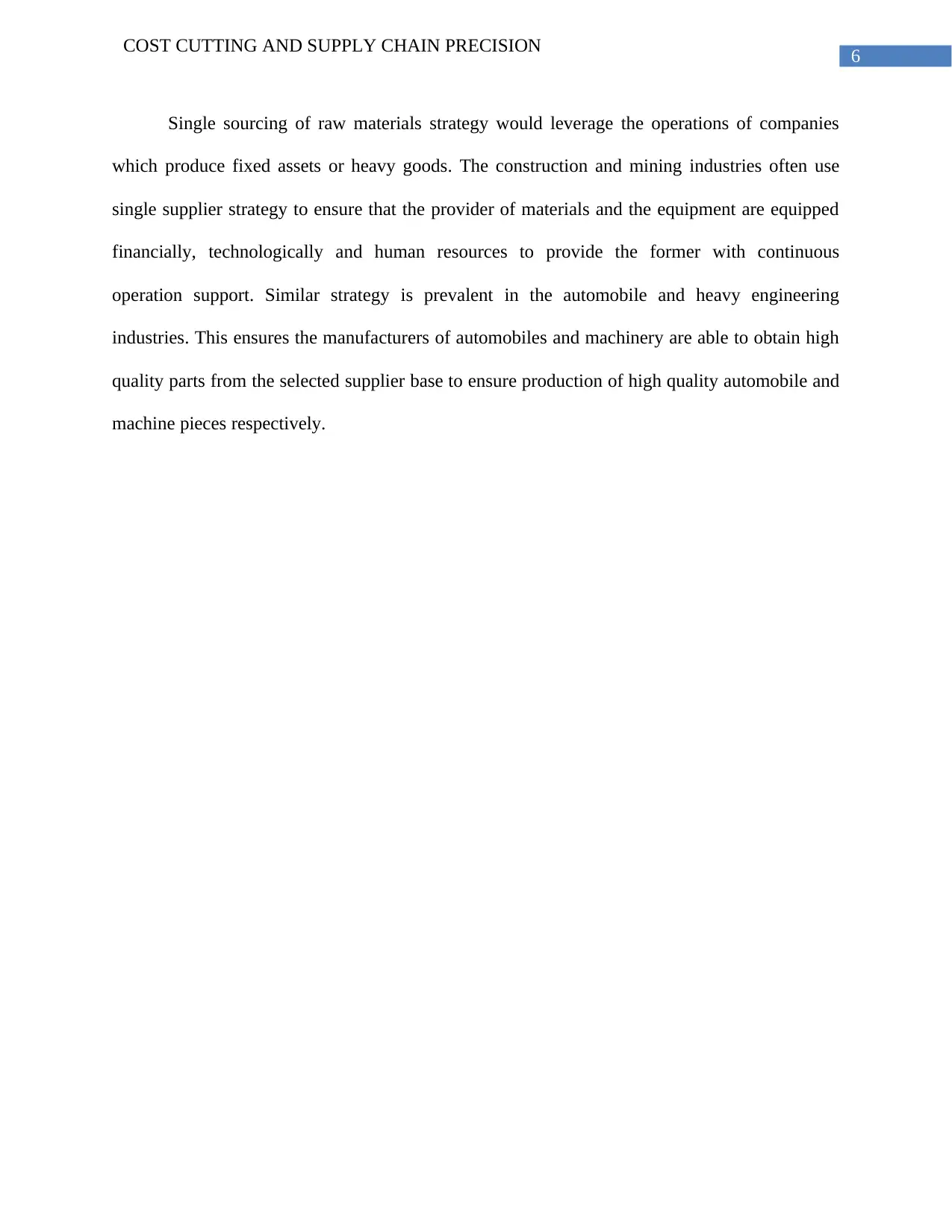
6
COST CUTTING AND SUPPLY CHAIN PRECISION
Single sourcing of raw materials strategy would leverage the operations of companies
which produce fixed assets or heavy goods. The construction and mining industries often use
single supplier strategy to ensure that the provider of materials and the equipment are equipped
financially, technologically and human resources to provide the former with continuous
operation support. Similar strategy is prevalent in the automobile and heavy engineering
industries. This ensures the manufacturers of automobiles and machinery are able to obtain high
quality parts from the selected supplier base to ensure production of high quality automobile and
machine pieces respectively.
COST CUTTING AND SUPPLY CHAIN PRECISION
Single sourcing of raw materials strategy would leverage the operations of companies
which produce fixed assets or heavy goods. The construction and mining industries often use
single supplier strategy to ensure that the provider of materials and the equipment are equipped
financially, technologically and human resources to provide the former with continuous
operation support. Similar strategy is prevalent in the automobile and heavy engineering
industries. This ensures the manufacturers of automobiles and machinery are able to obtain high
quality parts from the selected supplier base to ensure production of high quality automobile and
machine pieces respectively.
Paraphrase This Document
Need a fresh take? Get an instant paraphrase of this document with our AI Paraphraser
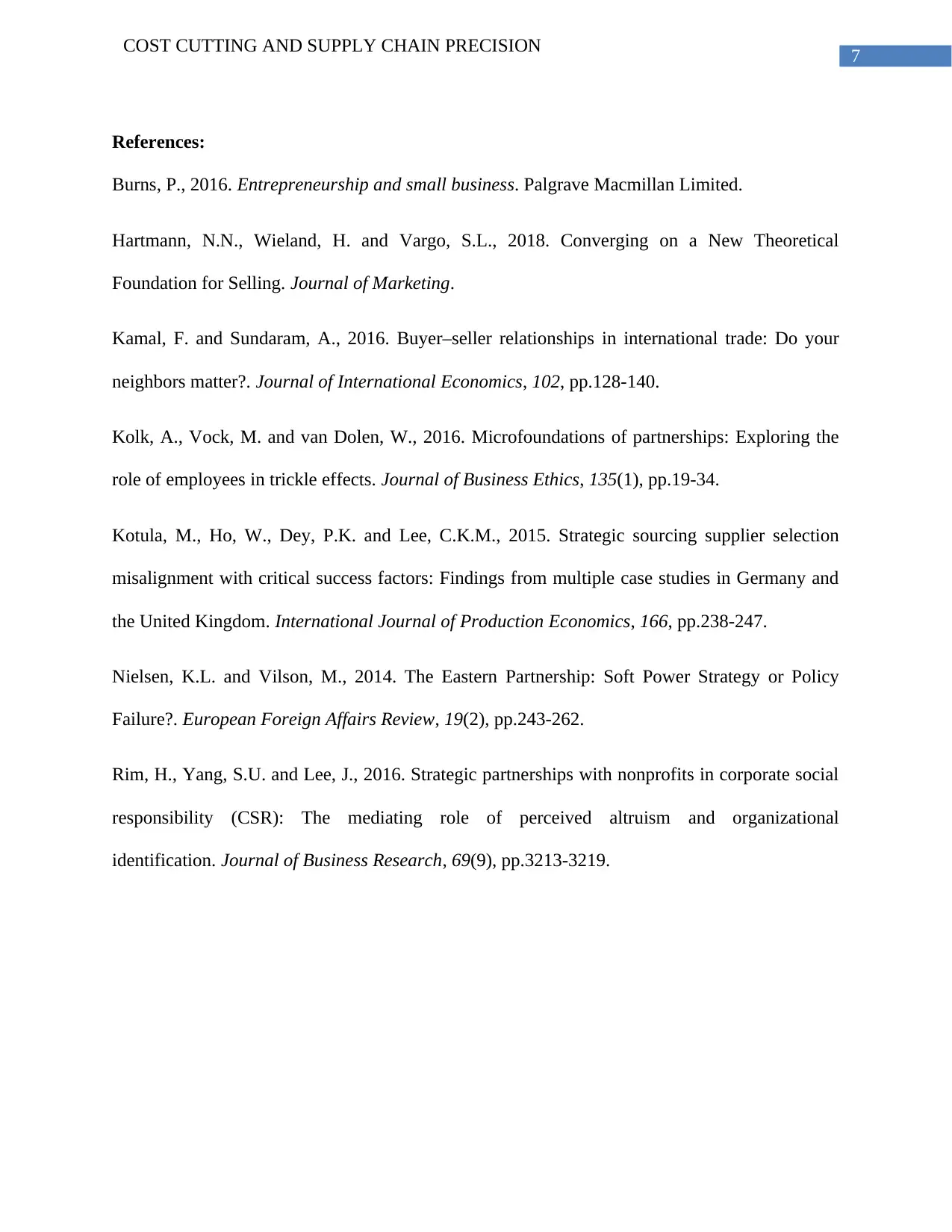
7
COST CUTTING AND SUPPLY CHAIN PRECISION
References:
Burns, P., 2016. Entrepreneurship and small business. Palgrave Macmillan Limited.
Hartmann, N.N., Wieland, H. and Vargo, S.L., 2018. Converging on a New Theoretical
Foundation for Selling. Journal of Marketing.
Kamal, F. and Sundaram, A., 2016. Buyer–seller relationships in international trade: Do your
neighbors matter?. Journal of International Economics, 102, pp.128-140.
Kolk, A., Vock, M. and van Dolen, W., 2016. Microfoundations of partnerships: Exploring the
role of employees in trickle effects. Journal of Business Ethics, 135(1), pp.19-34.
Kotula, M., Ho, W., Dey, P.K. and Lee, C.K.M., 2015. Strategic sourcing supplier selection
misalignment with critical success factors: Findings from multiple case studies in Germany and
the United Kingdom. International Journal of Production Economics, 166, pp.238-247.
Nielsen, K.L. and Vilson, M., 2014. The Eastern Partnership: Soft Power Strategy or Policy
Failure?. European Foreign Affairs Review, 19(2), pp.243-262.
Rim, H., Yang, S.U. and Lee, J., 2016. Strategic partnerships with nonprofits in corporate social
responsibility (CSR): The mediating role of perceived altruism and organizational
identification. Journal of Business Research, 69(9), pp.3213-3219.
COST CUTTING AND SUPPLY CHAIN PRECISION
References:
Burns, P., 2016. Entrepreneurship and small business. Palgrave Macmillan Limited.
Hartmann, N.N., Wieland, H. and Vargo, S.L., 2018. Converging on a New Theoretical
Foundation for Selling. Journal of Marketing.
Kamal, F. and Sundaram, A., 2016. Buyer–seller relationships in international trade: Do your
neighbors matter?. Journal of International Economics, 102, pp.128-140.
Kolk, A., Vock, M. and van Dolen, W., 2016. Microfoundations of partnerships: Exploring the
role of employees in trickle effects. Journal of Business Ethics, 135(1), pp.19-34.
Kotula, M., Ho, W., Dey, P.K. and Lee, C.K.M., 2015. Strategic sourcing supplier selection
misalignment with critical success factors: Findings from multiple case studies in Germany and
the United Kingdom. International Journal of Production Economics, 166, pp.238-247.
Nielsen, K.L. and Vilson, M., 2014. The Eastern Partnership: Soft Power Strategy or Policy
Failure?. European Foreign Affairs Review, 19(2), pp.243-262.
Rim, H., Yang, S.U. and Lee, J., 2016. Strategic partnerships with nonprofits in corporate social
responsibility (CSR): The mediating role of perceived altruism and organizational
identification. Journal of Business Research, 69(9), pp.3213-3219.
1 out of 8
Related Documents
Your All-in-One AI-Powered Toolkit for Academic Success.
+13062052269
info@desklib.com
Available 24*7 on WhatsApp / Email
![[object Object]](/_next/static/media/star-bottom.7253800d.svg)
Unlock your academic potential
Copyright © 2020–2025 A2Z Services. All Rights Reserved. Developed and managed by ZUCOL.





